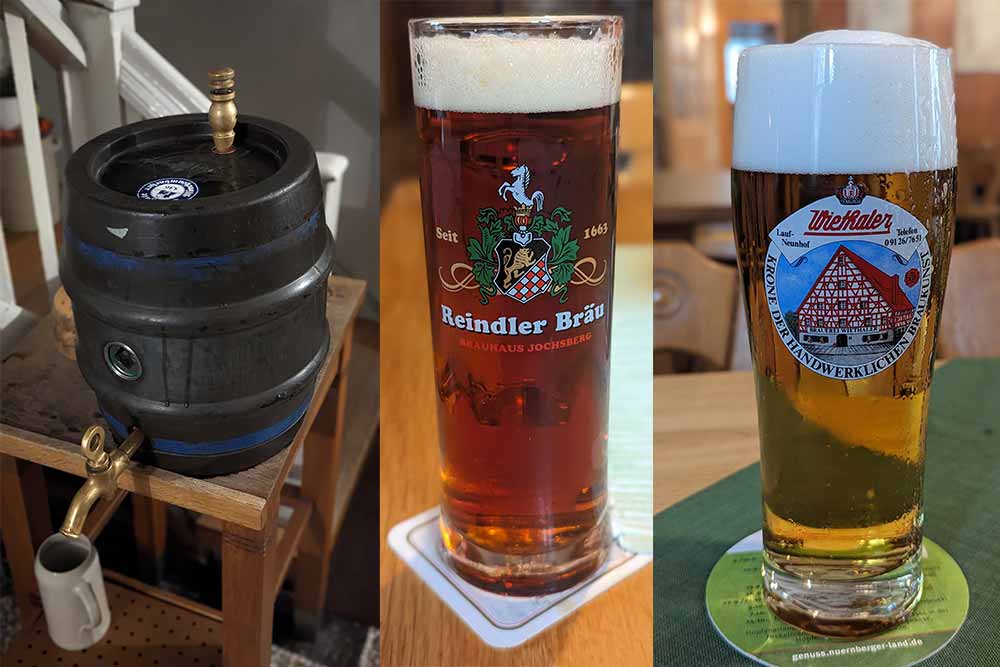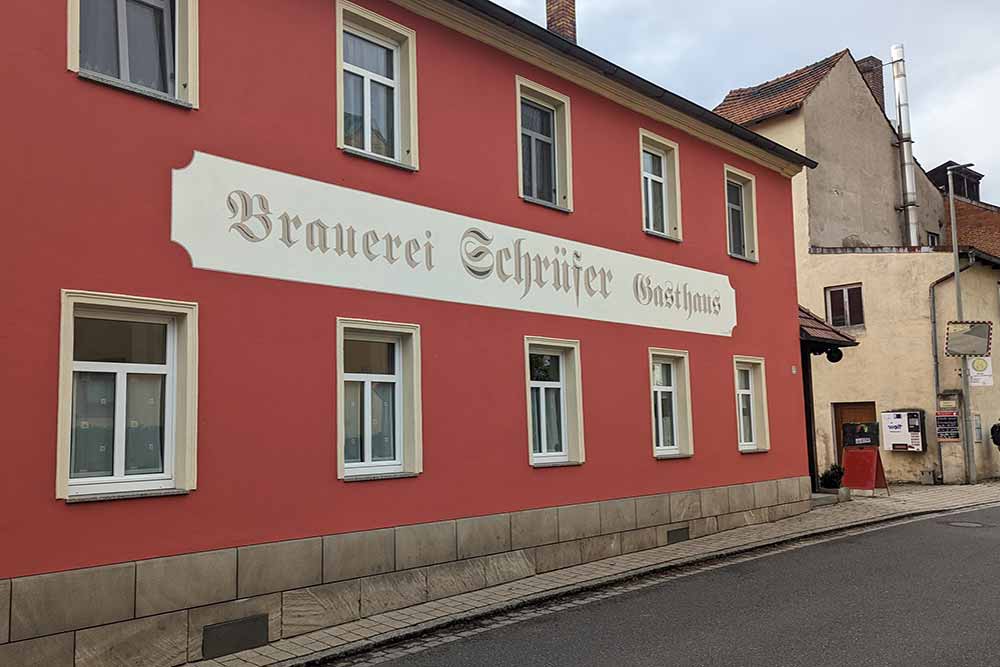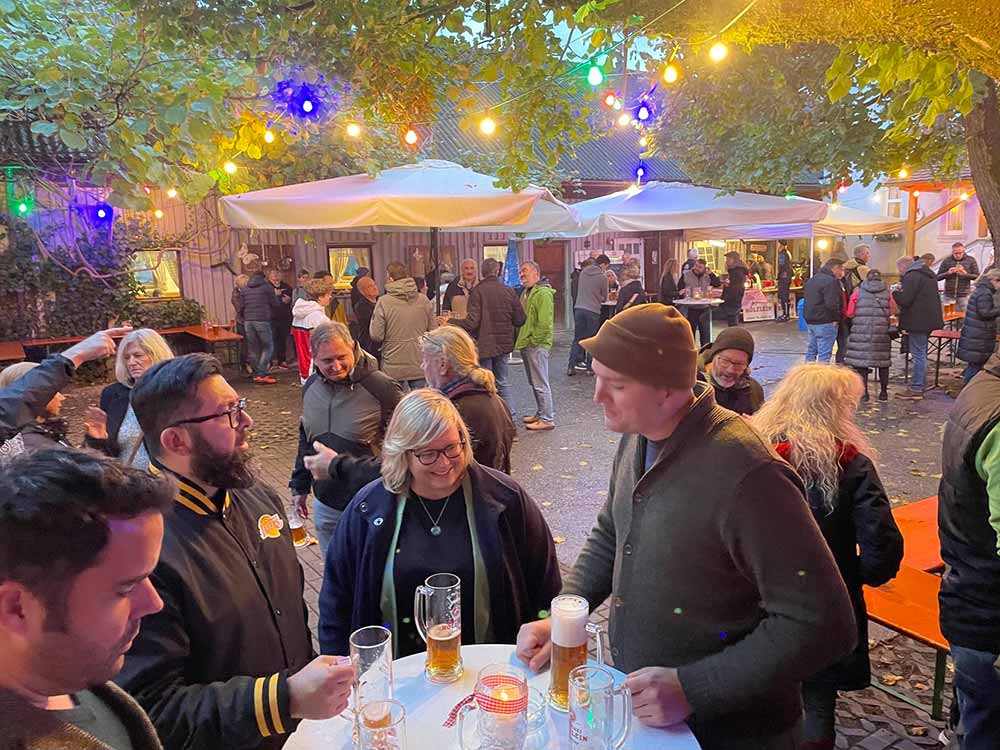Shop
Everything You Need to Know About Visiting Franconia’s Rich Beer Scene
Looking for More International Travel Guides?
At Gold Ochsen in the tiny Franconian town of Spielbach, I sat at a communal table where a retired farmer seemed intent on explaining the history of the brewer’s star, an age-old six-sided symbol often found in brewery logos. The only problem? He seemed to know maybe a hundred English words–about twice as many words as I know in German. Nevertheless, he gestured and pointed, exchanging a few foreign words back and forth as we sat drinking round after round of the brewery’s only beer.
In Franconia, a region of Germany located about halfway between Cologne and Munich, while styles like kellerbier, a relatively young, unfiltered lager, often come to mind, it’s the people who really stand out. They are so eager to share their wealth of knowledge about the area, the breweries, and the history—all over a few beers.
“Franconian beer is a product of history, tradition, and place,” says the English-born Jason Watts, who first visited the region in 2007, falling in love with it and moving there permanently in 2016.
Last fall, as I spent a week traveling across Franconia, I started to understand the allure, meeting plenty of fantastic people, visiting countless exceptional breweries, and drinking quite a few beers in the city and all through the countryside. Let’s dive into my glimpse of what the region has to offer and get a few tips from some of the folks that I met along the way.
Start With Smoky Beers in Bamberg
Probably the two most frequented beer tourist spots in Bamberg, and really all of Franconia, are the are the pub and brewery Schlenkerla and Spezial, respectively. These places exclusively serve rauchbier, or smoke beer. The massive crowds at the brewery location of Schlenkerla, often lining the street out front (where you can also drink the beer), make it a must-stop for most.
While both have an old-world charm, the beers are remarkably different. Schlenkerla has a more pronounced, deeper smoke flavor to its beers, while Spezial has an almost delicate smoke flavor comparatively. Spezial also has a legendary bierkeller, a pub that sits above the original underground beer cellars on a hill with sweeping views. So much has been written about these two breweries already, but suffice it to say they deliver on the hype.
The one-two punch of Mahr’s Bräu and Brauerei Keesmann is another popular visit within Bamberg city limits. The Keesmann Herren Pils has a striking bitterness but a rounded malt flavor underneath to balance. It’s a beer that many visitors put on their shortlist.
Similarly, Mahr’s has the “U,” or Ungespundet, which means unbunged. While no longer served by gravity, the beer remains a favorite of many locals and visitors.
The E.T.A. Hoffmann at Mahr’s is also quite delicious–it’s a dunkel more in line with the type of dunkel you’d find in Munich. Deep, dark, and delicious, with layered chocolate and caramel flavors, it is not to be missed.
Another notable spot in Bamberg is Brewery FaesslaKlosterbräu Bamberg, which serves one of the darker, roastier versions of a schwarzbier they call Schwärzla. Weyermann, the famous maltster, also operates a small pilot brewery, offers tours, and has an impressive gift shop.
A short bus or train ride and walk, or even a bike ride from Bamberg, is Brauerie Eichhorn in Dorfleins. This is one of Watts’ favorite places to drink. The lineup includes a kellerbier, a type of beer that sort of transcends what most people think of when it comes to beer styles.
This unfiltered lager is served relatively young, often with a little less carbonation, especially when it comes from a gravity barrel. The result is a lively, spunky type of beer, often softer and rounder, with lower carbonation and still present yeast. Often served in a ceramic mug, called a Krug, with a puffy head, kellerbier’s actual color can be challenging to see. That said, it’s often golden to amber in color. Some sulfur and even diacetyl are not out of the ordinary but are usually well integrated with the other components of the beer, particularly in the better examples.
But Don’t Miss Drinking in the Countryside of Franconia
Most people will make Bamberg their home base when visiting Franconia. Undoubtedly, you should visit those exceptional aforementioned breweries. But every beer lover should make it a point to venture outside of the main towns to the small villages that line the countryside, even if only for an afternoon or evening.
To the Southwest

Brauerei Zehendner lager from the barrel (on the left), Reindler Brau dunkel (in the middle), and Wiethaler lager (on the right) | Photography courtesy of Ryan Pachmayer
For instance, about a twenty-minute drive west of Bamberg, you’ll find one of Watts’ regular haunts, Brauerei Zehendner in Mönchsambach. There, Brewmaster Stefan Zehendner navigates the dining room like a hawk, eagerly waiting to replenish empty Krugs and glasses with fresh beer, while his wife runs the equally excellent kitchen.
Tradition runs deep at Zehendner. The brewery has been in his family since 1938 and still serves a lager from the barrel by gravity. The way it should be, according to Watts. The beer goes down far too easily as you chat the night away with friends, new and old. It also holds up to scrutiny—wonderfully complex with a soft edge due to the lighter carbonation and a rustic malt component to balance the more hop-forward nature of Zehendner’s beers.
Don’t confuse hop-forward for anything resembling a pale ale, let alone an IPA. The beer is not an outlier by any means either—plenty of other breweries tilt more heavily toward hop bitterness or flavor. Instead, you’d be hard-pressed to find another brewery in the region integrating the hops as well as Zehendner does.
Without a vehicle or interest in a roughly thirty-five-mile round-trip bike ride from Bamberg, you’ll have to navigate the bus schedule and time your visit to Zehendner just right.
To the West

Brauerei Schrüfer | Photography courtesy of Ryan Pachmayer
Biking, however, is Jose Santos Caro’s preferred way to visit breweries here because you can’t go too far without bumping into one.
Stationed in Franconia in 1996, the California native admits that the region wasn’t his first choice. “I wanted Korea, Italy, or my home state of California,” he says. Slowly but surely, the place won him over. He met his girlfriend in 1997, who he is still with to this day, and many friends along the way. “I can’t see myself living anywhere else,” he says.
Santos Caro lives for the summer gardens and kellers of Franconia, where he relishes the opportunity to drink beer from centuries-old breweries.
Santos Caro counts himself as a regular at Brauerei Bayer in Theinheim, an over-300-year-old brewery well worth a visit, especially for its landbier, a somewhat hard-to-define designation that means “country beer,” or a beer from the land.

Collection of Bockbier | Photography courtesy of Jose Santos Caro
Another of his regular haunts is Brauerei Schrüfer in Priesendorf. Schrüfer regularly serves a vollbier hell and dunkel in the fall to winter. I’m told that the dunkel has some variation, as it was one of the more bitter, hoppy beers I encountered on my own visit. It had enough malt to provide some balance underneath but finished dry enough to tempt another sip—it worked; I had three before I left.
The family-run Brauerei Schrüfer has been around for over 150 years, and with the father getting older, the family’s children recently moved back from all over the globe to lend a hand. This is a common way of life for breweries in Franconia–many are passed on from generation to generation. The problem is that not every family has children who are interested or able to take the brewery over. Unfortunately, that has led to an ever-growing number of breweries simply disappearing. If you drive through the tiny villages in the countryside, you’ll see evidence of these former breweries—the signs and sometimes even brewing equipment are often left alone, a symbol of what used to be.

Brauerei Bayer Krug of landbier (on the left) | Photography courtesy of Jim Spaulding. Brauerei Schrüfer Dunkel (on the right) | Photography courtesy of Ryan Pachmayer
Fortunately, Franconia still has over two hundred breweries in the region. Not far from Brauerei Schrüfer, in the tiny town of Weiher, is Brauerei Kundmüller. Run by brothers Oswald and Roland Kundmüller, the brewery turns 150 years old this year. The brewery made just a single beer thirty years ago. Today, it brews more than thirty, including some American craft styles. The brewery has a close relationship with Ohio’s Fat Head’s Brewery. It’s probably not a coincidence that Fat Head’s keeps winning medals in the U.S. for its hefeweizen beers, while Kundmüller has been winning medals in Europe for its IPAs (among other styles).
To the East and South

Brauerei Schrüfer open fermentation tank | Photography courtesy of Ryan Pachmayer
Frank Trosset is in the process of opening Volks Bräu in the Bay Area in 2024, a brewery influenced entirely by Franconia, the beers, and the culture. The former co-founder of Aslan Brewing in Bellingham, Washington, lived in Franconia for almost a year, working for a small family-run brewery in a tiny village of about two hundred people. He lived with the sixth-generation brewery-owner family for the entirety of the time that he worked for them.
“Franconian lager is the perfect bisection of drinkability and intrigue,” says Trosset. The way Trosset sees it, there is a lot of highly drinkable lager in the world, but it lacks a real intrigue. That intrigue, he says, primarily comes down to the process of making the beer. Breweries in Franconia are most often open fermenting the beer, and plenty are still using coolships for the lagers. Not every brewery uses these techniques, but Trosset says there’s an edge to the beers produced using these more rustic methods, as he puts it. Like those at Gradl.
Near the top of Trosset’s list of recommendations is Brauerei Gradl. A train from Bamberg will get you to Pegnitz, where you’ll have to arrange a taxi or walk the five miles to the brewery. “The dunkel [there] is so unique,” says Trosset. He describes it as hoppy, roasty, and deeply satisfying. “It’s very popular in its village and among beer nerds,” he adds.
South of Bamberg, Trosset also recommends Brauerei Witzgall, whose vollbier and landbier Trosset calls the best of their kinds in Oberfranken, or Upper Franconia. This brewery is far easier to reach—a short train ride south, followed by a quick walk or bus, will get you there. Trosset recommends a bike ride if it’s nice out.
When Should You Visit Franconia?

Holzlein Bockbieranstich in the garden | Photography courtesy of Jim Spaulding
It depends on what you want, according to Watts. Christmastime has the holiday festivities and markets. If you want Bamberg primarily to yourself, mid-January to just before Easter is the quiet time.
May is a lovely time for warm but not hot weather—and it also happens to be when the bierkellers are open.
Summer has the longest days and most consistent weather, but it can also get hot. Also, many places close for a holiday in August.
Then, with autumn comes the bockbier season.
Many Americans only have exposure to the doppelbocks in and around Munich. Those are great beers, and they’ve inspired some fantastic examples stateside. Franconia, however, has a broader range of bockbier and far more examples to choose from. The region also tends to celebrate the tapping of these beers in what is referred to as a bockbieranstich.
You’ll find examples of bocks in Franconia ranging from pale to dark, hoppy, malty, or both, dry and sweet, of moderate strength to high in alcohol. It runs the gamut. Because these beers are usually only brewed once each year, they tend to change a bit from year to year, making the bockbier season particularly adventurous. It’s also a time to celebrate.
Santos Caro tries to go to as many tappings as he can during the bock season. “They have really turned into a huge, crowded party festival,” he says, adding that it can sometimes be overwhelming. Some of Santos Caro’s favorite bockbieranstiches include those from Ulrich Martin, Spezial, Hölzlein, Ebensfelder, Brauhaus Rattelsdorf, Hoh, Kommunbräuhaus Unfinden, and Kaiser.
Further Exploration in Franconia

Greif Hell | Photography courtesy of Ryan Pachmayer
Taking the train down to Forchheim will result in a bountiful reward. The Kellerwald is a special place–a collection of over twenty kellers dug into the side of the hill. Beer and food are served from small buildings or structures, and the extensive gardens in the forest are filled with patrons. The season usually starts in April and continues until October, though you’ll find some kellers open throughout the year. This special place is at its busiest in July, when it hosts Annafest. You might call it Franconia’s answer to Oktoberfest, as the ten-day festival offers 1-liter Krugs of beer for the tens of thousands of daily patrons, along with plenty of food and other festivities.
Down the hill in the main town, you’ll find several breweries worth a stop. Brauerei Neder and Greif have a sort of old-guard feel to them. Neder’s Schwarze Anna was one of my favorite black lagers from the region, while the Hell from Greif was excellent from the barrel.
A complete guide to Franconian beer would require a multi-hundred-page book. The closest thing you’ll find in English is Rich Carbonara’s wonderful Beer Wanderers website.
Carbonara is an American expat living outside Munich with his German wife. Carbonara fell in love with Franconian beer and has developed quite an extensive resource with his website. He also gives guided tours, many of which involve hiking to and between breweries. He even wrote the book Beer Hiking in Bavaria. What separates Carbonara from many other beer guides is his willingness to take people off the beaten path to those rare gems that are out of the way.
Another fantastic resource is the Facebook group Franconia & the Oberpfalz Beer Group. Led by Watts, the group is English-speaking and geared towards the visitor. Within the group, you’ll find recent updates about out-of-the-way breweries, not to mention answers to numerous questions about transportation, logistics, and recommendations.
Franconia should be on the top of the list for any serious beer lover. The sheer number of breweries—inside Bamberg and throughout the countryside and in small villages—is remarkable. Finding hidden gems and experiencing a unique drinking culture in a picturesque setting means memories that will last a lifetime.




